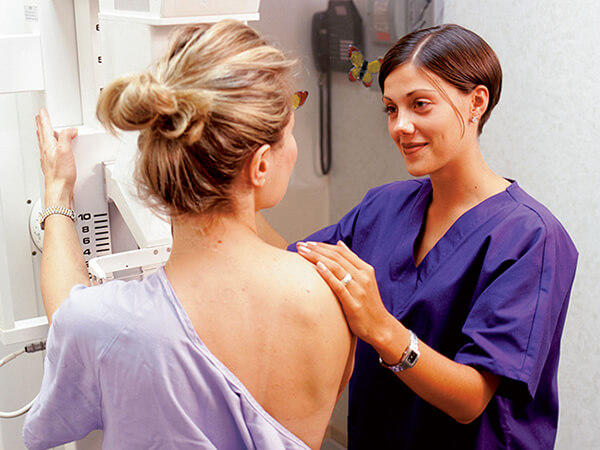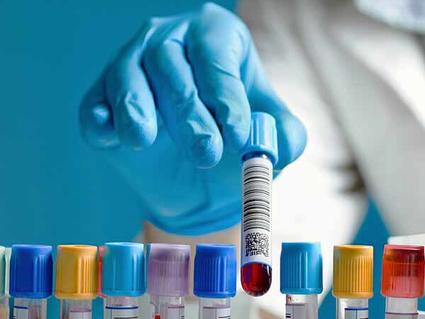
Why Research on Screening and Early Detection Is Critical to Progress against Cancer
Some patients whose cancers are detected and treated early may have better long-term survival than patients whose cancers are not found until symptoms appear. Unfortunately, effective screening tests for early detection do not exist for many cancers. And, for cancers for which there are widely used screening tests, many of the tests have not proven effective in reducing cancer mortality.
But, there have been some important successes in screening and early detection. Deaths from cervical cancer in the United States, for example, declined substantially after annual screening with the Pap test became common practice, and screening for colorectal and breast cancer have also been shown to reduce mortality from these cancers.
Although research on cancer screening and early detection can be challenging, the potential rewards—in terms of cancer deaths avoided—make it an extremely important and valuable area of study.
Opportunities in Cancer Screening and Early Detection Research
A greater understanding of the underlying biology of many cancers, as well as technological advances in areas such as imaging, are creating new avenues for advances in screening and early detection.
In addition, population-based studies have identified groups of people—often part of specific racial, ethnic, or socioeconomic groups—who are more likely to be diagnosed with certain cancers. As a result, researchers are now studying ways to improve the use of and access to proven screening methods in these population groups.
Importantly, studies performed over the last decade have strongly suggested that, in addition to benefits, screening has downsides. In particular, there is the risk of overdiagnosis and overtreatment—the diagnosis and treatment of cancers that would not threaten life or cause symptoms.
Overdiagnosis and overtreatment expose patients unnecessarily to the potential physical harms of unneeded and often invasive diagnostic tests and treatment, as well as to the psychological stresses associated with a cancer diagnosis. This understanding has led to intensive study of ways to identify and distinguish those screen-detected cancers that are truly life threatening and require immediate treatment from those for which treatment is unnecessary or can be safely delayed.
Based on this research and other studies, investigators are pursuing key opportunities, including:
- developing "liquid biopsy" technologies that can noninvasively identify the presence of genetic material from cancer cells in the blood or molecular markers in urine or saliva that can identify precursor lesions or cancer at its earliest stages
- identifying and validating biomarkers that may distinguish aggressive, life-threatening cancers from non-life-threatening tumors
- identifying genetic changes that point to potential avenues for more effectively monitoring people at increased risk of cancer
- testing interventions, such as the use of health navigators and tailored outreach and education programs, to increase the use of approved, effective screening tests among certain population groups
- better quantifying the benefits and harms of screening tests, as well as the relative contributions of cancer screening and improvements in treatment on mortality rates
Challenges in Cancer Screening and Early Detection Research
As with research on cancer prevention, time is a challenge when developing and testing new interventions for screening and early detection. Years or decades are often needed to determine whether an intervention, such as a new screening test or a patient risk assessment, reduces the number of people diagnosed with advanced cancer or who die from cancer. And these studies can be expensive and logistically challenging to conduct.
Discovering and validating biomarkers that can accurately identify people at increased risk of cancer or who have potentially lethal cancers has also proven to be very difficult. Many biomarkers that have shown promise in early studies have not been validated subsequently in more advanced testing—consuming valuable time and resources.
In addition, screening and early detection on their own are often not enough. Ensuring that individuals receive the appropriate follow-up and treatment after a cancer diagnosis is essential but has proven to be difficult, particularly for those from low socioeconomic settings and certain racial or ethnic groups, resulting in delayed treatment and worse outcomes.
NCI's Role in Cancer Screening and Early Detection Research
Improving Early Detection
Some early detection tests for cancer can help reduce deaths from the disease and may limit the need for extensive treatment, which can cause substantial side effects and longer-term health issues. NCI supports a wide variety of programs and studies designed to advance the science of early detection.
- Discovering and validating biomarkers that can help diagnose cancer at its earliest stages is the primary mission of NCI's Early Detection Research Network (EDRN). A number of biomarkers discovered by EDRN-supported researchers are being studied to determine whether they are ready for clinical testing, including biomarkers for prostate, pancreatic, ovarian, and esophageal cancer.
- Increased sensitivity in cancer screening enables the detection of very early lesions, but usually does not distinguish between those that are likely to progress and those that would never threaten life or cause symptoms. NCI’s Division of Cancer Prevention (DCP) and Division of Cancer Biology (DCB) collaboratively support research to identify and assess the cellular and molecular factors that drive progression (or identify overdiagnosis) in screen-detected lesions. New imaging, genomics, and proteomics technologies are providing ways to study the degree to which the behavior of these early lesions is predictable and thus allow better management of screen-detected abnormalities.
- DCP and Division of Cancer Treatment and Diagnosis collaboratively support research that correlates findings from studies testing various imaging modalities for the early detection of cancer with similar biomarker studies. The goal is to improve the overall efficacy of screening, not only by combining these approaches to detect cancer earlier, but to also reduce the number false-positive screening tests.
- NCI family studies have identified the genetic causes of several hereditary cancers. For example, researchers from NCI's Division of Cancer Epidemiology and Genetics (DCEG) are investigating hereditary melanoma and a rare cancer called chordoma, as well as the genetic factors behind cancer-predisposition syndromes like Li-Fraumeni and dyskeratosis congenita. Findings from these efforts also help researchers better understand the molecular underpinnings of nonhereditary cancers and identify people at increased cancer risk who may need to be closely monitored for the development of those cancers.
- NCI has also established a biorepository of tissue samples from specimens collected as part of one of the largest cancer screening studies ever conducted, the Prostate, Lung, Colorectal and Ovarian (PLCO) Cancer Screening Trial. The PLCO biorepository serves as a national resource for all investigators studying biomarkers, the early stages of cancer development, and many other areas.
Enhancing Screening
Improving the accuracy of cancer screening tests, how they are used, and expanding the use of and access to tests that have been shown to reduce cancer mortality are clear needs being addressed by NCI-led and -supported programs.
- Through the Consortium for Molecular Characterization of Screen-Detected Lesions, which is supported by DCP and DCB, multidisciplinary research teams at 15 institutions are carrying out comprehensive molecular and cellular analyses of tumor tissue and components of the tumor microenvironment, with the goal of characterizing the differences between early noninvasive and invasive lesions detected through cancer screening and cancers that arise between screenings, called interval cancers, and cancers detected by symptoms.
- DCEG researchers have led efforts to improve screening for cervical cancer, including how to most effectively incorporate DNA testing for the human papillomavirus—which is responsible for nearly all cases of cervical cancer—into the highly successful screening approach, based on Pap testing, that helped to dramatically reduce cervical cancer deaths in the United States.
- NCI’s Population-based Research Optimizing Screening through Personalized Regimens (PROSPR) program supports research to better understand and improve how screening for breast, colorectal, and cervical cancer is conducted in everyday practice. This includes studying ways to increase screening among population groups for whom screening rates have been historically low and to ensure that patients who do undergo screening receive the appropriate follow-up care.
- NCI sponsored the landmark National Lung Screening Trial (NLST), which showed that screening people at high risk of lung cancer with low-dose, helical computed tomography (LDCT) scans reduced their risk of dying from lung cancer by 20 percent when compared with patients screened with traditional chest x-rays. The Centers for Medicare & Medicaid Services used NLST results to develop its coverage policy for lung cancer screening with LDCT. Researchers are continuing to analyze NLST data to better understand the impact of CT-based screening, including whether there are subgroups of people at increased lung cancer risk who are more or less likely to benefit from regular screening.
- NCI established the Breast Cancer Surveillance Consortium (BCSC) as a resource for researchers studying the delivery and quality of breast cancer screening in the United States. The BCSC enables assessments of U.S. breast cancer screening practices in terms of accuracy, cost, and quality and the relation of these practices to breast cancer stage at diagnosis, survival, and mortality.
- NCI’s Community Oncology Research Program (NCORP) conducts prevention and screening clinical trials at community hospitals and clinical practices across the United States. NCORP trials can include the study and evaluation of new screening tests and preventive interventions, as well as post-treatment surveillance studies to determine the optimal frequency of follow-up screening.
- In the fall of 2016, NCI's Center to Reduce Cancer Health Disparities launched the National “Screen to Save” Colorectal Cancer Outreach and Screening Initiative. The aim of the initiative is to increase colorectal cancer screening rates among racially and ethnically diverse communities and in rural areas. Working through the NCI-supported National Outreach Network, community health educators will partner with community-based organizations, institutions serving underrepresented populations, and other clinical and academic organizations to deliver colorectal cancer screening information and conduct culturally tailored outreach within their communities
Posted:
Updated:
Reviewed:
Syndicated Content Details:
Source URL: https://www.cancer.gov/node/915676/syndication
Source Agency: National Cancer Institute (NCI)
Captured Date: 2015-08-29 01:00:58.0
Source URL: https://www.cancer.gov/node/915676/syndication
Source Agency: National Cancer Institute (NCI)
Captured Date: 2015-08-29 01:00:58.0






No comments